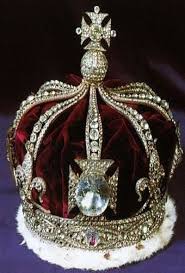Hi my dear friends, how are you? I hope you'll be safe and healthy everybody! Today we are going to know more about a "dangerous diamond" because diamonds are very beautiful but sometimes, "dangerous", too. This is the story of the Koh-i-Noor Diamond.
Hola mis queridos amigos, ¿cómo estáis? Espero que todos estéis bien y con salud. Hoy vamos a saber más sobre un "peligroso diamante" porque los diamantes son muy bonitos pero a veces, también "peligrosos". Esta es la historia del Diamante Koh-i-Noor.
Info: from Speak Up magazine.
Photos: artofliving.org / postcard.news / kohinoorjewels,net / kohinoor.org
THE KOH-I-NOOR / THE WOLD'S MOST DANGEROUS DIAMOND
The Koh-i-Noor diamond is the centrepiece of the British Crown Jewels. It is arguably the most famous gem in the world. But it is also the most dangerous. Countless people have lost their lives in the fight to possess it, the result, many believe, of a terrible curse. In Persian, Koh-i-Noor means "The Mountain of Light". Its origins are a mystery, but most experst think it came from a river bed in India.
FIRST APPEARANCE
Its first verifiable appearance came in the middle of the 17th century, as the central gem in the Peacock Throne of the Emperor Shah Jahan, head of the Mughal empire in the Indian subcontinent. The diamond quickly became a symbol of power. It passed, through conquest, to the Persian ruler, Hader Shah, and then to his Afghan bodyguard, who establised a huge empire in Afghanistan and northern India.
EMBLEM OF POWER
The jewel was now one of the most famous emblems of power in the world. In the words of one Afghan queen: "If a strong man were to throw four stones, one north, one south, one east, one west, and a fifth stone up into the air, and if the space between them were to be filled with gold, all would not equal the value of the Koh-i-Noor." The Afghans finally lost the priceless gem to a Sikh military commander called Ranjit Singh at the beginning of the 19th century.
THE BRITISH EMPIRE
This is when British appeared in the story. Britain was in the process of building what would be the biggest empire in the world, and much of it was on the Indian subcontinent. The British wanted the Koh-i-Noor. Singh's ten-year-old son, Duleep, now the owner of the gem, was "persuaded" to hand it over in 1849 to the British, for the imperial Queen, Victoria.
BLOODY HISTORY
Queen Victoria had no idea of the bloody history of the diamond, or its curse. Over the centuries, as the gem passed from ruler to ruler, its 793 carats were covered in layer after layer of cruelty and suffering. Eyes were punctured with hot needles, people were cremated alive, and one torture victim died wearing a crown of molten lead.
Duleep's life was just another example. The British took Duleep to England with the diamond. Queen Victoria liked him but felt guilty over how the jewel had arrived in her hands. Happy at first, Duleep soon became bitter at his situation, and eventually left the court. He finally died in poverty.
WORLD DOMINATION
Th Koh-i-Noor had arrived in England as the symbol of Britan's domination of the world. It was presented at the Great Exhibition in London's Hyde Park in 1851.
The Exhibition was designed to show Britain's global domination, and six million people, thirty per cent of the British population, went to see it. The jewel was an enormous disappointment however, It was much smaller and less spectacular than people had expected. It was later made part of the Crown Jewels. Britain's current Queen, Elizabeth II, has never worn the gem. It was last seen on the coffin of the Queen Mother in 2002.
UNCERTAIN FUTURE
The future of the Koh-i-Noor is not clear. Several countries have demanded its return, including India, Pakistan, Afghanistan and Iran. Even the Taliban say they want it.
Will the jewel stay in the Tower of London?
SEE YOU!!!
I hope you'll like this story!!!






No hay comentarios:
Publicar un comentario